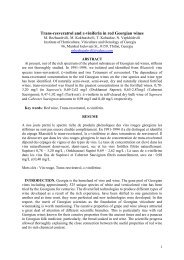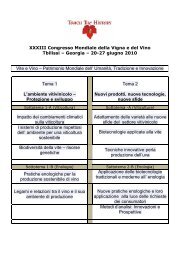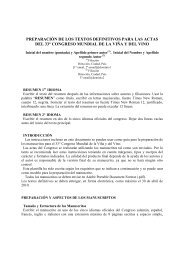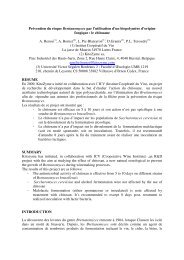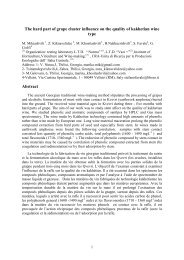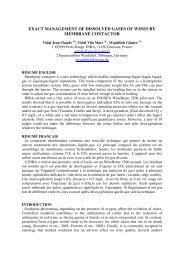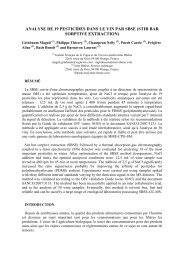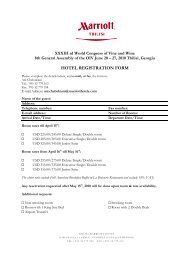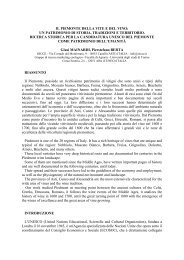Identification of Grape Varieties via Digital Leaf Image ... - Oiv2010.ge
Identification of Grape Varieties via Digital Leaf Image ... - Oiv2010.ge
Identification of Grape Varieties via Digital Leaf Image ... - Oiv2010.ge
Create successful ePaper yourself
Turn your PDF publications into a flip-book with our unique Google optimized e-Paper software.
The accuracy decreases when the number <strong>of</strong> varieties increases. We may resolve this<br />
problem by increasing the feature vector‟s dimensions, i.e. to find more features, and use<br />
better classification algorithm such as SVM [Wu et al., 2008]. The latter is a well known<br />
machine learning method for classification. It is in fact the capacity <strong>of</strong> computer to learn from<br />
examples. After having trained it by giving many leaf samples belonging to each grape<br />
variety, the s<strong>of</strong>tware can decide to which variety a new leaf belongs to.<br />
Our prototype can only classify scanned images. In order to classify digital camera images,<br />
we have to consider factors such as photography distance and focus. On the other hand, a<br />
camera may take photos from different angles. This may allow us to distinguish the prostrate<br />
hairs <strong>of</strong> a leaf from the erect hairs. However, this problem can be better resolved by a 3<br />
dimensions camera or scanner. Based on the 3D image technique, we can more easily<br />
calculate other leaf features such as the pr<strong>of</strong>ile <strong>of</strong> leaf (OIV code 74 [OIV, 2009]). Light wave<br />
lengths other than visible ones, such as infrared, microwave and terahertz [Lu, 2002; Xing<br />
and Baerdemaeker, 2005] etc. can also be used to obtain digital leaf images. These images<br />
should supply complementary features, useful for the variety identification. By combining<br />
these mentioned techniques, we are expected to be able to calculate all the 45 codes selected<br />
by OIV and hence to identify all grape varieties based on digital image processing by<br />
computer.<br />
This new identification method may not only simplify the identification procedure, but its<br />
techniques can also improve the classical ampelographic identification method. The current<br />
OIV Descriptor List [OIV, 2009] uses the code values in a qualitative way. For example, the<br />
code 65 for the size <strong>of</strong> blade takes values 1, 3, 5, 7 and 9 which means respectively, very<br />
small, small, medium, large and very large. Our method can calculate the size <strong>of</strong> blade in<br />
inch 2 or cm 2 effectively and automatically. We may do this for all quantifiable codes <strong>of</strong> all<br />
known varieties. With these quantitive values, we may give a value range for each current<br />
qualitative value on one hand, and check if the code values for the 250 varieties in [OIV, 2000]<br />
are coherent. These techniques can be used to detect new variety and guess the parent<br />
varieties <strong>of</strong> a new hybrid variety. In fact, the feature vector <strong>of</strong> a new variety will not belong to<br />
any known varieties, but a hybrid one should be close to its parents‟ ones. Computers<br />
s<strong>of</strong>tware can easily find out all the similar varieties and sort them according to the similitude.<br />
IV. Conclusions<br />
Based on the classical ampelographic grape identification method combined with machine<br />
learning and pattern recognition techniques in computer science, we proposed a new cheap<br />
and fast identification method <strong>via</strong> leaf image processing. We demonstrated its feasibility by<br />
implementing a s<strong>of</strong>tware prototype which could classify 354 leaf images belonging to 20<br />
varieties with an accuracy <strong>of</strong> 87%.<br />
We are continuing our research to increase both the number <strong>of</strong> grape varieties and the<br />
accuracy by calculating more features from digital images and improving the classification<br />
algorithms.



